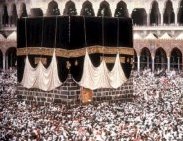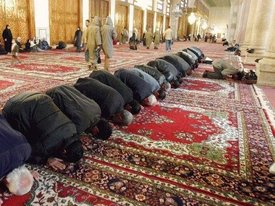Kaaba
|
|
The Kaaba or Ka'abah, is a building located inside the mosque known as Masjid al Haram in Mecca (Makkah). The mosque has been built around the Kaaba. The Kaaba is the holiest place in Islam.
| Contents |
Physical attributes of the Kaaba
The Kaaba is a large masonry building in the shape of a cube. It is made of granite from the hills near Mecca. The structure is 50 ft. high (15.24 m), 35 ft. (10.67 m) wide, and 40 ft. long (12.19 m) long. It is covered by a black silk cloth decorated with gold-embroidered calligraphy. This cloth is known as the kiswa; it is replaced yearly. [1] (http://www.theage.com.au/articles/2003/02/11/1044725746252.html) [2] (http://members.tripod.com/worldupdates/newupdates10/id43.htm)
One of the cornerstones of the Kaaba is the Hajar el Aswad (the sacred "Black Stone"), which is presumed by most sources to be a meteorite remnant.
Inside the Kaaba, there is a marble floor. The interior walls are clad with marble half-way to the roof; tablets with Quranic inscriptions are inset in the marble. The top part of the walls is covered with a green cloth decorated with gold embroidered Quranic verses. Lamps hang from a cross beam; there is also a small table for incense burners. The building is otherwise empty. The caretakers perfume the marble cladding with scented oil, the same oil used to anoint the Black Stone outside.
The cleaning of the Kaaba
The building is opened twice a year for a ceremony known as "the cleaning of the Ka'aba." This ceremony takes place roughly fifteen days before the start of Ramadan and the same period of time before the start of the annual pilgrimage. The keys to the Ka'aba are held by the Sheibani family. Members of the family greet visitors to the inside of the Ka'aba on the occasion of the cleaning ceremony. A small number of dignatories and foreign diplomats are invited to participate in the ceremony. The Governor of Mecca leads the honored guests who ritually clean the structure, using simple brooms.
History of the Kaaba
At the time of Muhammad, his tribe, the Quraysh was in charge of the Kaaba, which was at that time a shrine to numerous Arabian tribal gods. Desert tribesmen, the Bedouin, and inhabitants of other cities would join the annual pilgimage, to worship and to trade. Caravan-raiding, common during the rest of the year, was suspended during the pilgrimage; this was a good time, then, for travel and trade.
Muhammad, preaching the doctrines of one God (in Arabic, Allah) and the threat of the Day of Judgment, did not at first have much success in the city of Mecca. The Quraysh persecuted and harassed him continuously, and he and his followers eventually fled to Medina, in 622 C.E. After this pivotal flight, or Hijra, the Muslim community became a political and military force. In 630 C.E., Muhammad and his followers returned to Mecca as conquerors, and the Kaaba was re-dedicated as an Islamic house of worship. Henceforth the annual pilgrimage was to be a Muslim rite, the Hajj.
According to the Qur'an, the Kaaba was built by the prophet Ibrahim (Abraham) and his son Ishmael [3] (http://www.usc.edu/dept/MSA/quran/002.qmt.html#002.127). Academic scholars will only say that it is a pre-Islamic house of native Arab worship.
The Qibla and prayer
The Qibla, for any point of reference on the Earth, is the direction of the Kaaba. In Muslim religious practice, supplicants must face this direction in prayer.
It should be noted that Muslims do not worship the Kaaba or its contents, any more than Christians worship churches or crosses; the Kaaba is simply a focal point for prayer.
The Qibla points along the shortest path to the Kaaba. Because the Earth is approximately spherical, this path will be a great circle such as airplanes fly. The location of the Kaaba (at Template:Coor dms) can be used together with spherical geometry to determine the Qibla for any given point on the Earth.
In ancient times, Muslims traveling abroad used an astrolabe to find the Qibla.
In the early years of Islam, Muslims used to pray towards the Temple Mount in Jerusalem (and it is therefore called the First of the Two Qiblas). During Muhammad's exile in Medina, the Qibla was changed to the Kaaba, where it has remained ever since. Some academic scholars have attributed this change in the direction of prayer to a rift between Muhammad and the Jews in Medina.
See also
External links
- Wikisource: Calculation of the Qibla (http://sources.wikipedia.org/wiki/Calculation_of_the_Qibla)
- Pictures of Masjid al Haraam and the Holy Kaaba (http://haqaonline.lightuponlight.com/pg/thumbnails.php?album=1)ar:الكعبة المشرفة
da:Ka'ba de:Kaaba es:Kaaba eo:Kaaba fr:Ka'ba id:Ka'bah ia:Kaaba it:Kaaba he:כעבה nl:Ka'aba ja:カアバ pl:Kaaba pt:Kaaba ru:Кааба sv:Kaba


